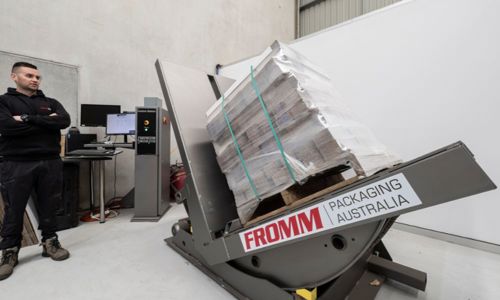Why Optimal Strap Tension Matters in Packaging
Why Optimal Strapping Tension Matters in Packaging
Strapping may be one of the final steps in your packaging process, but it plays a critical role in ensuring products arrive safely and securely. The tension applied to the strap - whether it's too much or too little - can make or break the integrity of your shipment.
Too little tension can cause loads to shift or become unstable during transit. On the other hand, too much tension can damage the product or even lead to strapping failure. Getting it wrong can be costly - financially and reputationally.
Finding the right balance of strapping tension enhances packaging safety, reduces product damage, and ensures reliable performance throughout the supply chain. In this article, we’ll unpack the risks of incorrect tensioning, explore influencing factors, and show how FROMM's solutions can help your business achieve consistent, safe, and efficient load securing.

What happens when strapping tension is incorrect
Under-Tensioning
When a strap is applied with too little tension, it can't properly secure the load. This results in movement during transport, leading to potential product damage, pallet instability, and safety hazards.
Over-Tensioning
Over-tightening the strap can crush products, damage packaging edges, or even break the strap itself. In some cases, this creates a false sense of security—until failure occurs during transport.
The Cost of Getting It Wrong
Whether the strapping is too loose or too tight, the consequences can be severe. Damaged goods, increased returns, and safety incidents all impact your bottom line and can harm your reputation with clients and distributors.
Factors that affect optimal strapping tension
Strap Material (Steel vs PET vs PP)
Different strapping materials behave differently under tension, making material selection crucial to achieving correct tension.
Steel Strap is ideal for securing very heavy or rigid loads.
Best for: Industrial applications requiring high tensile strength.
Watch out: Steel has no stretch, so it can't absorb shocks well and may damage products under high tension. Broken or cut steel strap can also have sharp edges and pose a significant safety hazard.
Polyester Strap (PET) provides excellent strength and elasticity.
Best for: Dynamic loads that may shift during transit.
Benefit: PET stretches slightly like a seatbelt, absorbing shocks and protecting the load.
Watch out: Over-tensioning diminishes its elastic properties and may lead to strap failure.
Polypropylene Strap (PP) is lightweight and cost effective.
Best for: Light duty applications or temporary bundling.
Watch out: Less suitable for heavy or palletised loads due to its lower strength.
Load Weight and Size
Heavy duty pallets require higher strap tension than smaller, lighter, or fragile items. It's important to assess the density and weight of the load before setting tension.
Shipping Environment
Transport conditions such as long distance travel, humidity, and temperature extremes can affect how a strap performs. Certain materials, such as polyester (PET), exhibit greater resistance to temperature fluctuations, while others may experience a loss of tension over time when exposed to extreme conditions.
Tool Type and User Skill
Manual tools rely heavily on operator consistency. Battery-powered strapping tools and automatic machines improve accuracy and reduce the risk of over- or under-tensioning.
Explore FROMM's handheld strapping tool range >
How to achieve optimal strapping tension
Incorrect strapping tension is often the result of manual guesswork, especially in low volume or manual operations.
For small to medium packaging volumes, battery powered strapping tools allow for preset tensioning and consistent application across operators and shifts.
For strapping higher volumes, automatic strapping machines deliver unmatched consistency, speed, and tension control without operator input.
Our FROMM industry experts have decades of experience in providing strapping solutions across a range of industries and products. We can recommend the ideal strapping pattern and tension to secure your products, improve safety and support your bottom line.
FROMM tools & machines designed for consistent tension
FROMM offers a comprehensive suite of strapping tools tailored to PET, PP, and steel materials. Here are three standout products from our range for each strapping material:
FROMM FSM35 Semi Automatic Strapping Machine - for PP strap
A high performance semi automatic machine ideal for continuous use and strapping a variety of different box sizes.
Key Features
-
High speed strapping
-
Automatic strap threading
-
Anti jam technology
-
Table top start sensor or foot pedal start
FROMM P329S Battery Powered Strapping Tool - for PET strap
A versatile, heavy duty tool with a touch screen designed for single handed operation
Key Features
-
Adjustable tension up to 4000 N
-
One-touch automatic mode for tension, seal, and cut
-
Long-lasting battery with quick recharge
-
Lightweight, ergonomic design
FROMM A480 Pneumatic Powered Strapping Tool - for Steel strap
Low weight tool ideal for strapping small bundles or any package with a small surface area.
Key Features
-
Tension up to 4500 N
-
Proven performer in strapping bars, bundles, pipes and coils
-
All in one tension, seal and cut
-
Single notch seal
Not sure which tool is right for you? Assess your operation’s needs and talk to a FROMM expert to get tailored advice.









